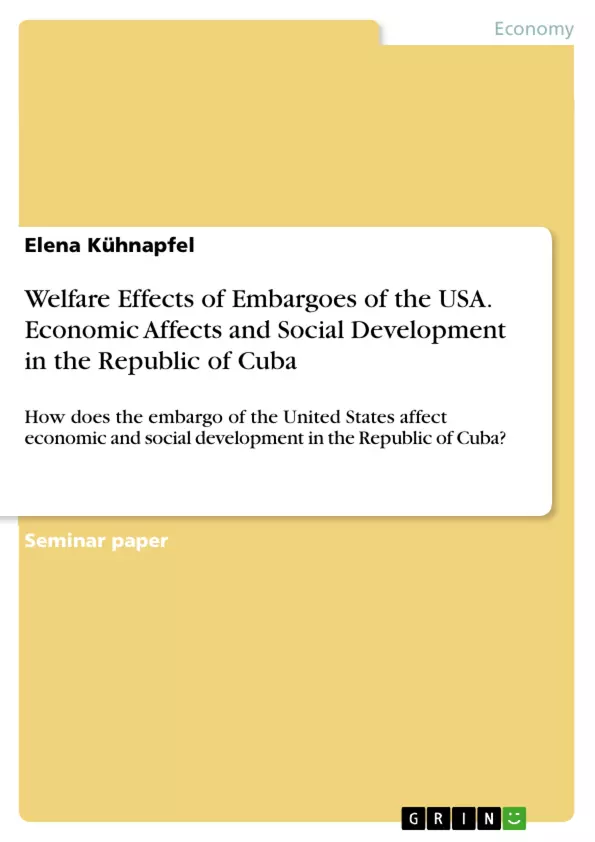This paper investigates welfare effects of embargoes based on the following research question: How does the embargo of the United States affect economic and social development in the Republic of Cuba?
Firstly, a general introduction and historic outline about the development of the US embargo imposed on the centrally planned island Cuba will be provided, especially focussing on the post-Soviet Union era. Secondly, a research gap has been investigated by compiling international scholars and their findings. However, recent developments are not yet addressed adequately in academic research papers, namely the re-establishment of diplomatic ties between the USA and Cuba. Further, based on Ricardo’s model of comparative advantages, the existence of a twofold discussion about trade diversity in Cuba has been identified. Thirdly, two hypotheses are raised: The embargo imposed on Cuba has more positive than negative effects on trade diversification (H1) and the embargo imposed on Cuba has negative social welfare effects (H2).
In order to answer the initial research question, two conceptual models are developed about trade and welfare effects of embargoes. The latter compares GDP and GDP per capita data as measurements for selected welfare indicators for Cuba and its neighbouring countries, whereas the former compiles the country’s trade partners and trade balance. The following discussion suggests a lifting of the embargo including political concerns on both sides, negative impacts on people and economy as well as the influence of the stakeholders. Finally, future political recommendations for welfare improvements in Cuba are suggested.
Inhaltsverzeichnis (Table of Contents)
- Abstract
- Table of Content
- Table of Figures
- List of Acronyms
- 1.0 Introduction
- 2.0 Literature Review
- 2.1 Streams of literature
- 2.2 General academic discussion
- 2.3 Deficiencies of the findings - Ricardo and political ideologies
- 2.4 Twofold discussion about trade diversity at times of the embargo
- 2.4.1 Positive effects on trade diversity
- 2.4.2 Negative effects on trade diversity
- 2.5 Evaluation of the literature
- 3.0 Conceptual Model
- 4.0 Methodology
- 5.0 Findings
- 5.1 Country comparison about welfare indicators
- 5.2 Total trade flows and balance
- 5.3 Cuba's main trade partners
- 6.0 Analysis and Discussion
- 7.0 Conclusion
- 8.0 References
Zielsetzung und Themenschwerpunkte (Objectives and Key Themes)
This research paper examines the welfare effects of the United States embargo on Cuba, focusing on its impact on economic and social development. The study aims to answer the research question: How does the US embargo affect economic and social development in the Republic of Cuba? To address this question, the paper analyzes international scholarly findings, identifies the research gap concerning recent developments in US-Cuba relations, and develops two conceptual models regarding the trade and welfare effects of embargoes. Finally, the study proposes future political recommendations for welfare improvements in Cuba.
- Impact of US embargo on Cuban economic and social development
- Trade diversification in Cuba under the embargo
- Welfare effects of embargoes on Cuba
- Conceptual models for analyzing trade and welfare impacts
- Future policy recommendations for improving welfare in Cuba
Zusammenfassung der Kapitel (Chapter Summaries)
- Chapter 1.0: Introduction: This chapter provides a general introduction and historical outline of the US embargo on Cuba, particularly focusing on the post-Soviet Union era.
- Chapter 2.0: Literature Review: This chapter presents a comprehensive overview of existing literature on the US embargo, including different streams of research, general academic discussion, and deficiencies in existing findings. It also explores the twofold discussion regarding trade diversity in Cuba during the embargo period, examining both positive and negative effects.
- Chapter 3.0: Conceptual Model: This chapter develops two conceptual models to analyze the trade and welfare effects of embargoes. These models serve as frameworks for understanding the impact of the US embargo on Cuba.
- Chapter 4.0: Methodology: This chapter outlines the research methodology used to analyze the impact of the embargo, including data sources and analytical approaches.
- Chapter 5.0: Findings: This chapter presents key findings based on data analysis, including comparisons of welfare indicators across countries, analysis of Cuba's total trade flows and balance, and identification of Cuba's main trade partners.
- Chapter 6.0: Analysis and Discussion: This chapter provides a comprehensive analysis of the findings, interpreting their significance and discussing the implications of the US embargo on Cuba's economic and social development.
Schlüsselwörter (Keywords)
The research paper explores the impact of the US embargo on Cuba, focusing on welfare effects, trade diversity, and unilateral sanctions. It examines relevant concepts such as comparative advantages, Ricardo's model, and economic development. The study utilizes indicators like GDP, GDP per capita, and trade balance to assess the consequences of the embargo. Key stakeholders, political considerations, and potential solutions for improving welfare in Cuba are also discussed.
- Quote paper
- Elena Kühnapfel (Author), 2015, Welfare Effects of Embargoes of the USA. Economic Affects and Social Development in the Republic of Cuba, Munich, GRIN Verlag, https://www.grin.com/document/296313



